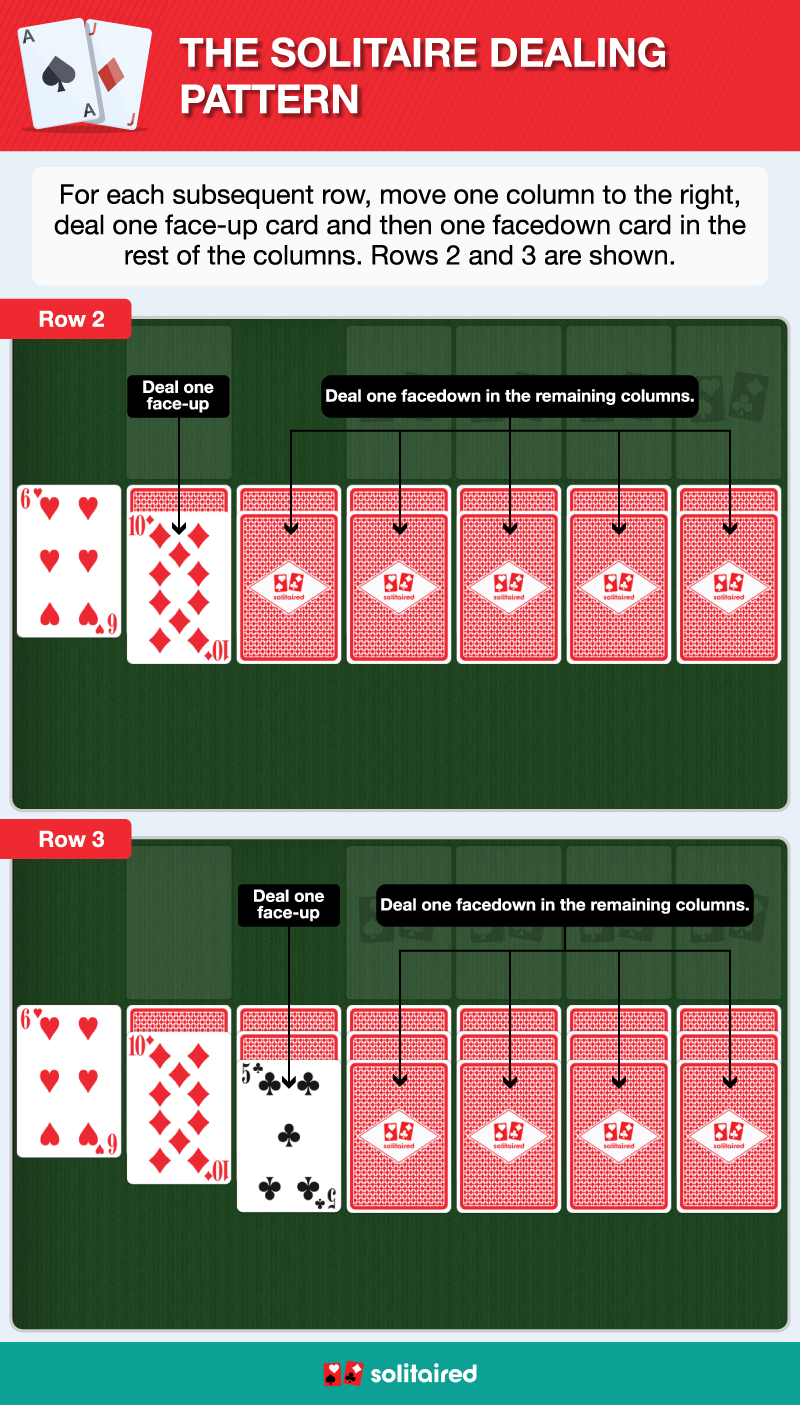How to Set Up Solitaire
By Neal Taparia - 08/23/2023

You set up Solitaire by shuffling a 52-card deck and dealing 28 cards into seven columns. Each column should have the same number of cards that correspond to its order. So the first column has one card, the second has two cards, and so on. Deal across the columns from left to right. All cards are dealt facedown except for the top card in each column, which should be turned face-up.
The following sections offer more details on the setup as well as the setup for variations and how to play Solitaire.
Solitaire Setup: Dealing the Tableau
Although you use four sets of piles for gameplay, you’re only building one, the tableau, when you set up the game. After you shuffle the cards, create the main area of gameplay—the tableau—by dealing seven columns of cards that follow a pattern.
1. Begin by dealing one card face-up and six more facedown in a horizontal row.
This is the foundation for the seven-column tableau.

2. Beginning with the second column, deal a card face-up.
It should slightly overlap with the facedown card. Deal facedown cards overlapping the rest of the columns in the row.

3. Repeat this pattern to complete the tableau.
Once you complete the second row of cards, move to the third column—deal a face-up card slightly overlapping the facedown card and deal facedown cards overlapping the rest of the columns in the row. Continue until the last card you deal is a face-up card on the last column.

Now you should have seven columns of cards, and the number of cards in each column should match the order of the column. For example, the first column has one card, the second column has two cards, the third column has three cards, and so on.
Visually, from left to right the tableau should cascade downward, forming a reverse staircase, and the last card in each column should be face-up.
The Complete Solitaire Setup
You use four different piles when you play Solitaire. Once you’ve set up the tableau, place the rest of the cards in the stockpile and leave space for the waste pile and foundation piles.

Here’s how each section functions:
- Tableau: The main area of gameplay, you arrange face-up cards in the tableau by alternating color and descending in rank. You can use from the waste pile and the foundation piles to help build sequences.
- Stockpile: The cards left over after you deal the tableau become your stockpile and should be placed facedown in the upper left corner above the tableau. As you progress through the game, you can draw from this pile when you run out of moves on the tableau.
- Waste pile: As you turn over cards from the stockpile, these face-up cards form a waste pile. The top face-up card in this pile can be used to arrange cards in the tableau or to play in the foundation piles.
- Foundation piles: The foundation piles are four piles for each suit in which you place cards ascending from ace to king. When playing Solitaire, the goal is to place all the cards into the foundation piles, but that means you won’t have any foundation piles when you begin. So save space at the top of your gameplay area for four foundation piles to be played.
How to Play Solitaire
Once you’ve set up your tableau and made room for the other piles, you are ready to play! Your goal is to get your best Solitaire score by arranging all of cards in ascending order by suit into the four foundation piles. To do so, you can make these moves:
Play face-up cards in a specific sequence.
You can play any face-up cards, so you can building your foundation piles or arrange your tableau. For foundation piles, separate by suit and begin them with aces, ascending in order to king. For the tableau, you can move cards by alternating color and descending in rank. For example, a red six can be moved on top of a black seven, or a black jack and be placed on top of a red queen.

Move entire columns, not just single cards.
You can move entire columns of face-up cards or a single card, but if you have an empty space in the tableau, only a king or a column starting with a king can be moved there. Rearranging cards in the tableau helps reveal facedown cards, making them available to play.

Use the waste pile when you get stuck.
As you progress, continue building on your foundation piles and use the waste pile to help you make moves. Although you can cycle through the stockpile endlessly, if you run out of moves in the tableau and have cycled through the entire stockpile without being able to move any cards, the game is over.

If you aren’t sure how to begin, you can learn how to play Solitaire by checking out our guide that offers advice on moves and strategy.
If you find yourself wanting to play Solitaire but don’t have the space or cards handy, you can always play Solitaire online, which is quick and convenient. And once you get the hang of it, try other varieties like Spider Solitaire or FreeCell—each offer a unique setup and a different challenge.
Setups for Solitaire Variations
To try out a variation, you just need to know how to set them up. In these sections, we give you the setups of popular Solitaire variations and an overview of how to play so you can get started.
Yukon
Deal the tableau piles just as you would with classic Solitaire. Then add four additional face-up cards to each column except the first one. Then you will have dealt the entire deck, so there is no stockpile or waste pile. You still build foundation piles like you would in classic Solitaire.
In Yukon Solitaire, you build sequences in descending order alternating by color, but, unlike classic Solitaire, you can move a column of cards regardless of sequence and colors as long as the card at the top of the column being moved is one rank lower than the card it’s placed on and alternating in color.

FreeCell
Using one deck, you deal the entire tableau of FreeCell Solitaire with face-up cards. From left to right, deal eight columns of cards with seven cards in the first four columns and six cards in the last four columns. Four free cells remain open in the upper left in which you can move cards as you play.
Your goal is to build four foundation piles by suit in the upper left corner of the tableau, starting with aces and ascending to king. You can also build descending sequences that alternate by color in the tableau to free up cards you need. While you can move single cards, you can also move as many cards in a column at one time as there are open cells plus one. So if three free cells are open, you can move a column of four cards.

Pyramid
As the name implies, you deal the tableau for Pyramid Solitaire with rows of cards placed in a pyramid shape. Beginning with one card, deal all cards face up with overlapping rows until you complete the final row of seven. Place the rest of the remaining cards into the stockpile facedown, and try to clear the entire pyramid tableau.
Remove cards from the pyramid by pairing exposed cards that equal 13 when added. Jacks are worth 11, queens are worth 12, and kings are worth 13, which means kings are the only card that doesn’t need to be paired. All other cards are worth whatever number they are. So a jack and a two can be paired as they equal 13. If you’re stuck, you can turn cards from the stockpile face-up into the waste pile to use as well.

Golf
To deal the main tableau for Golf Solitaire, place five face-up cards into seven columns, dealing left to right. Turn up a single card from the waste pile and put the rest of the cards facedown in the stockpile. Your goal is to clear all of the cards from the tableau
To move cards out of the tableau, match one that is one rank higher or lower than the face-up card in the waste pile. For example, if a three of clubs is in the waste pile, you can play any four or any three, and the card you play becomes the new top card in the waste pile.

Spider Solitaire
Use two decks of cards to deal 10 columns in the tableau from left to right, placing six cards into each of the first four columns and five into the other six. The last card in each column should be face-up. Place the remaining cards into the stockpile.
You move cards from column to column in descending order from king to ace. You can even move an entire column of cards. If you get stuck, you deal one face-up card at the bottom of each column. Once you have a complete descending column, it should be placed into the foundation piles at the top right of your game space. Place all the cards into foundation piles to win.

Once you know the basic patterns, setting up different types of solitaire is simple! If you don’t have a deck of cards or would rather play online, try all of our free solitaire games.
About the author

